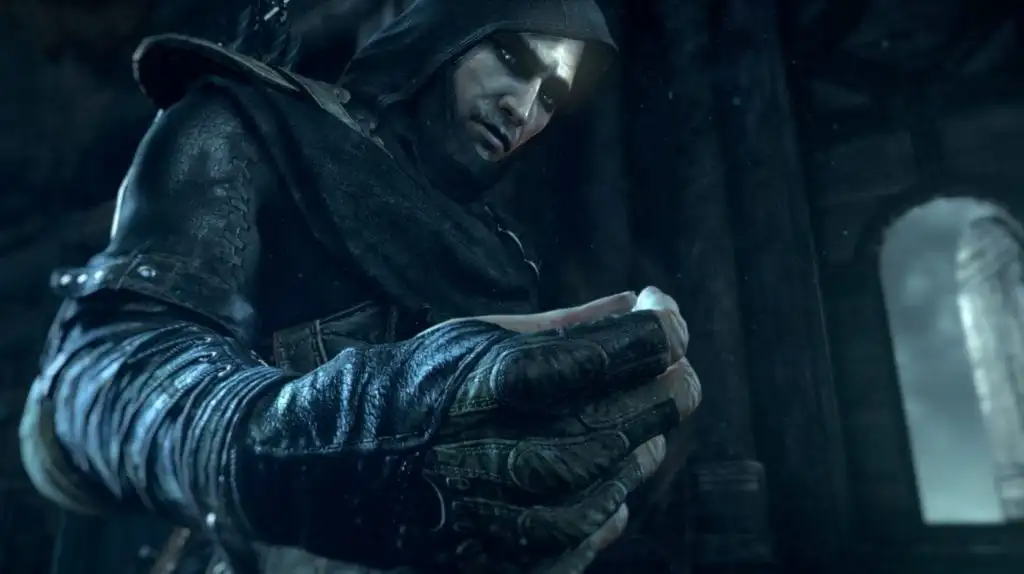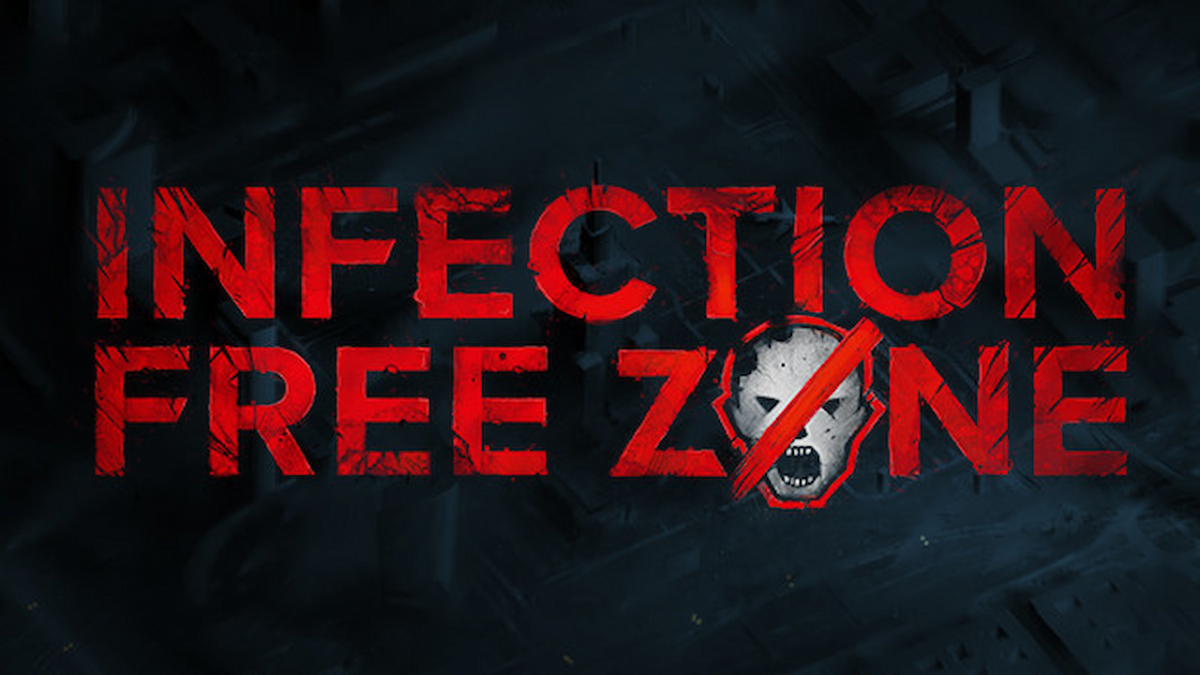a long-time fan of the Thief series, I’ve spent the last couple of years watching Eidos Montreal handling the license with all the apparent grace and judgment of a drunken juggler. Those balls have now spilled into the audience’s lap, revealing this reboot to be a disjointed affair that manages to bungle just as many of the series fundamentals as it gets right, and one which struggles against the constraints of its own design.
I don’t hate the new Thief, I’m just sad and disappointed that a series as vital as this one has been mismanaged so grievously.
In Eidos’ clean-slate version of the City, Garrett finds himself paired up with Lost Girl cosplayer Erin who, throughout the course of a tutorial Prologue mission, reveals herself to be an arrogant murderer. Rather than rejoice when the job goes wrong and Erin tumbles into a big blue portal, Garrett gets crushed by some masonry and wakes up one year later with a headache and the burning desire to slope off back to his new clock-tower hideout.
Thief’s story only goes downhill from there, featuring ill-defined characters who flit in and out of the narrative like moths drawn to terrible dialogue, and cut-scenes that appear to have been produced long before the levels they’re supposed to accompany were actually completed. At one point I read a collectible newspaper and learned about a fairly substantial plot point before I’d even played the chapter in which it takes place. In addition, parts of that plot seem to have been designed by just cutting out key phrases from Dishonored and BioShock Infinite, putting them in a hat, and drawing out some winners. “Mystery plague” and “violent revolution leading to more oppression” took the honours here.
Eidos don’t quite seem what to know what do with their version of Garrett. He’s either a guilt-ridden father figure, a swaggering, cocksure thief, or a kleptomaniac with obsessive hoarding issues. In a better written game he could probably be all three, but here he just comes across as the product of multiple writing teams failing (or refusing) to communicate with one another.
New voice actor Romano Orzari doesn’t do a bad job, even raising the odd smile with a classic Garrett quip or two, but too often he’s left working with over-written lines and embarrassing clichés. Stephen Russell is missed as a vocal talent (not least because of his ability to put a voice to multiple characters,) but even he couldn’t save some of this material from sounding like over-eager fan-fiction. By the end of the game I was thankful that he wasn’t involved with this project.
Since Thief has provided a wealth of welcome customisation options for players to tweak and alter their experience of the game, it makes sense for me to mention how I played for the majority of my time with the title. I aimed for a HUD and mechanics as close to the original Thief series as possible, which meant disabling Garrett’s magical Focus power (this game’s eagle vision/detective vision/instinct equivalent) as well as all the navigational and waypoint marker aids. I also switched off threat meters, health bars, interaction prompts and basically anything else that clutters up the screen with hand-holding rubbish. Loot glint seemed quite aggressively bright, so that was ditched too. I left object highlighting on, and would say that distinguishing between theft items and clutter, not to mention wall textures and switches, would be rather tedious without it.
Thief is quite playable with those settings and mostly steers clear of the problem that I’d feared prior to release; that certain sections would be designed with Focus usage heavily in mind. Without interaction prompts it can take a short while to recognise when a pile of crates is actually a loading zone for Garrett to push through rather than a dead end, but otherwise I didn’t meet too many issues with my options set-up. I do wish there was a toggle for the white flashes that occur at the peripheries of the screen when Garrett leaves the shadows, because these are pretty irritating and aren’t really necessary if the player is already using the light gem.
Thief: The Dark Project and Thief II: The Metal Age are referenced as classics of first-person stealth thanks to exemplary level design that emphasised player freedom, an engine designed around effective sound propagation and a pair of pretty tight stories. This Thief is hopeless when it comes to consistent narrative, and feels constrained by design choices that prevent any truly memorable missions.
At their worst, Thief’s main missions are little more than cinematic corridor stealth sections in which Garrett has to make his way from point A to point B. It isn’t always a straight line, sometimes it’s a semi-circle or a zig-zagging climb. But the outcome is the same; linear progression with the occasional binary deviation at points where the designers felt generous enough to give you a second path in order provide the illusion of freedom. The poorest missions are restrictive and, criminally, peppered with loading zones that will sometimes prevent back-tracking. Did you accidentally cross an unmarked loading zone before you were done exploring? Tough, you can’t go back.
As a result, too many of Thief’s locations feel like videogame levels rather than actual places. From outside, the second chapter’s Foundry looks like a huge building, akin to the storage warehouses in Thief II’s Shipping and Receiving mission. In reality it’s a compartmentalised sequence of blocks with six to ten rooms each, connected by loading zones that are literally on a rail.
During many of these outings Garrett, the ‘Master Thief,’ gets himself caught in unavoidable cinematic sequences. In fact, it happens in the Prologue (though that’s not really Garrett’s fault) Chapter 2, Chapter 3, Chapter 4 (twice) and Chapter 6. This is a lovely slap in the face for people who took the painstaking time to ghost, unseen, through the mission, only to have that work undone in frustrating, scripted fashion. Contrast this approach with the climax of Thief II’s outstanding Life of the Party mission, where an apparently unavoidable alarm-triggering sequence can actually be disabled ahead of time.
This is all the more maddening, because at times the Eidos team demonstrate that they know what makes a decent Thief mission and actually get quite close to constructing one. Chapter 4 opens with a decent mansion infiltration, complete with multiple points of entry and a building that actually feels functional and lived in, rather than a haphazard series of rooms connected by loading zones. Unfortunately, the conclusion of this section triggers an unskippable escape sequence during which the player barely interacts with the Dramatic Action™ exploding around their face. The second half of the mission looks as though it will take place in an imposing tower, but immediately devolves into funneling the player through smoke-filled corridors.
A shameless re-tread of Thief: Deadly Shadows’ Shalebridge Cradle mission threatens to be of interest, but relies too much on cheap jump-scares and suffers from the fact that the same kind of Haunted House level construction trick won’t really work on Thief fans twice.




